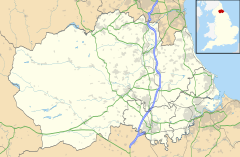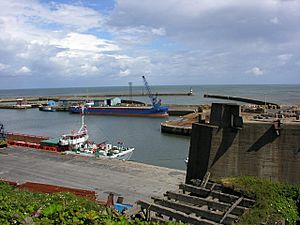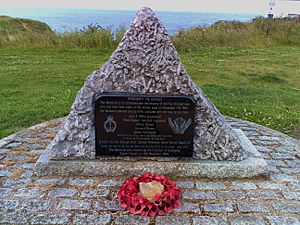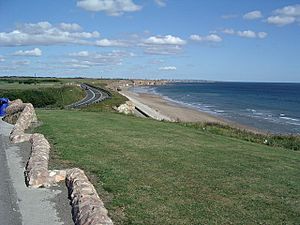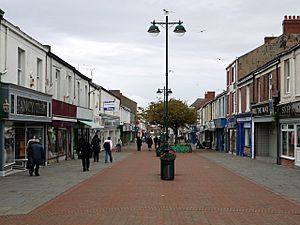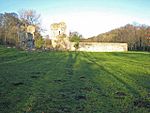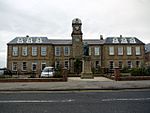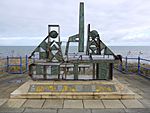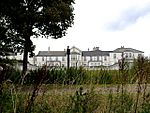Seaham facts for kids
Quick facts for kids Seaham |
|
|---|---|
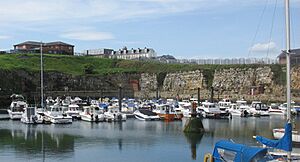 Seaham's Marina |
|
| Population | 20,172 |
| OS grid reference | NZ426496 |
| Civil parish |
|
| Unitary authority |
|
| Ceremonial county | |
| Region | |
| Country | England |
| Sovereign state | United Kingdom |
| Post town | SEAHAM |
| Postcode district | SR7 |
| Dialling code | 0191 |
| Police | Durham |
| Fire | County Durham and Darlington |
| Ambulance | North East |
| EU Parliament | North East England |
| UK Parliament |
|
Seaham (pronounced SEE-əm) is a lovely seaside town in County Durham, England. It sits right on the Durham Coast, about 6 miles (10 km) south of Sunderland. It's also about 13 miles (21 km) east of the city of Durham. Seaham grew a lot from the late 1800s. This was thanks to new investments in its busy harbour and important coal mines. Seaham is also connected to the German town of Gerlingen as a twin town.
Contents
Discovering Seaham's Past
The very first village of Seaham has mostly disappeared today. It was located near St Mary's Church and Seaham Hall. St Mary the Virgin is the local church. It was built a very long time ago, in the late 600s! Its main part looks a lot like the old church at Escomb.
How Seaham Grew from a Small Village
Before the early 1800s, Seaham was just a small farming village. Its biggest claim to fame was a wedding! The daughter of the local landowner, Anne Isabella Milbanke, married the famous poet Lord Byron at Seaham Hall. This happened on January 2, 1815. Byron even started writing some of his Hebrew Melodies here. They were published a few months later. It seems Byron found Seaham a bit boring in winter. But he loved watching the sea. He once wrote to a friend:
Upon this dreary coast we have nothing but county meetings and shipwrecks; and I have this day dined upon fish, which probably dined upon the crews of several colliers lost in the late gales. But I saw the sea once more in all the glories of surf and foam.
Byron's marriage didn't last long. They had one child, Ada Lovelace, who became a famous mathematician. In 1821, the Milbanke family sold their land to the 3rd Marquess of Londonderry. He changed Seaham's future! In 1828, he built a harbour to help transport goods. The first coal mine in the area opened in 1845.
Expanding Seaham Harbour
The first harbour wasn't big enough for all the coal. So, the 6th Marquess hired engineers Patrick Meik and Charles Meik. They made the harbour bigger and deeper. It officially opened in 1905. This harbour is special because it uses many connecting locks. Most harbours just have two walls.
In 1823, the 3rd Marquess asked architect John Dobson to design a new town around the harbour. Dobson drew up plans, but there wasn't enough money to build it exactly as planned. So, the town grew bit by bit instead. At first, the new town was called Seaham Harbour. This helped tell it apart from the old village. Over time, the whole area became known simply as Seaham.
Glassmaking and Coal Mining in Seaham
In 1853, John Candlish built the Londonderry Bottleworks in Seaham. This was the largest glass bottle factory in Britain! It operated until 1921. Candlish later became mayor of the town. He also became a Member of Parliament for Sunderland. Waste glass from the factory was dumped into the sea. Now, you can find these glass pieces, called sea glass, washed up on local beaches.
The last coal mine in Seaham, Vane Tempest, started production in 1928. But by 1992, all three local mines had closed. These were Dawdon Colliery, Vane Tempest Colliery, and Seaham Colliery (known locally as "the Knack"). The British miners' strike helped speed up these closures. The closing of the mines was very hard on the local economy.
Tragedies in Seaham's History
Seaham Colliery had a terrible underground explosion in 1880. More than 160 people died, including workers and rescuers. Many local families were also affected by the 'Seaham Lifeboat Disaster'. This happened on November 17, 1962. Eight men and one boy died when the RNLI lifeboat, the George Elmy, sank. To remember this sad event, the new coast road was named George Elmy Lifeboat Way.
Learning and Sports in Seaham
Education in Seaham
Seaham has one secondary school for students, called Seaham High School. Before 2016, it was known as Seaham School of Technology.
Sports Teams in Seaham
Seaham's main football team is Seaham Red Star F.C.. They used to be called Seaham Colliery Welfare Red Star. The club plays in the Northern League Division One.
Seaham also has two cricket clubs: Seaham Harbour Cricket Club and Seaham Park Cricket Club. Both senior teams play in the North East Premier League.
In the 2019-20 rugby season, Seaham RUFC moved up a league. They were promoted from Durham/Northumberland 3 to Durham/Northumberland 2.
Seaham in Movies and TV
Seaham and nearby areas have been used as filming locations!
- The very last scene of the 1971 film, Get Carter, was filmed at Blackhall Rocks beach, which is near Seaham.
- The 2000 film Billy Elliot showed a lot about the town's mining history. The movie was set during the 1984–85 UK miners' strike. It showed life in mining communities like Seaham. Parts of the film were shot in Seaham, like the Dawdon Miners' Club.
- The opening scene in Alien 3 (1992) was filmed on Blast Beach, at Dawdon.
- Seaham was also a location for the film Life For Ruth (1962).
- The town appeared in the BBC Three sitcom Live!Girls! present Dogtown in 2006.
- A two-part Channel 4 documentary about Seaham was shown in 1991.
Important Places and Statues
To the south of Seaham, you can find the remains of Dalden Tower. These are the ruins of a tower from the 1500s.
The harbour itself is a very important landmark from the 1800s. The Londonderry Institute on Tempest Road, built in 1853-55, shows what the Marquess had hoped the town would look like. It has a grand Greek-style entrance. The former Londonderry Offices on the seafront were once the main offices for the Londonderry family's mining businesses. A statue of the 6th Marquess stands outside. St John's Church in the town centre was built between 1835 and 1840. For the much older St Mary's Church and Seaham Hall, see the history section above.
The Old Seaham Lighthouse
For over 100 years, a 58-foot (18 m) lighthouse stood on Red Acre Point, north of the harbour. It was built in 1835. This lighthouse had a special light pattern to tell it apart from other lighthouses nearby. It was turned off in 1905 when the harbour was made bigger. A new black-and-white striped light was built on the pier. The old lighthouse stayed as a landmark until 1940. It was quickly taken down so it couldn't help enemy ships during the war.
The Tommy Statue
A steel statue called 1101, also known as Tommy, stands on Seaham's seafront. It was created by local artist Ray Lonsdale. This statue remembers World War One. It was first put up for only three months. But in 2014, local people raised money to keep it there permanently!
Famous People from Seaham
Between 1929 and 1935, the Member of Parliament (MP) for Seaham was Ramsay MacDonald. He was a Labour Prime Minister. The area's current constituency, Easington, has always elected Labour MPs.
Seaham has also produced many talented footballers! Some have played for the local team, Sunderland, like Richie Pitt and Gary Rowell. Terry Fenwick and Brian Marwood even played for England. Brian Marwood later became a commentator for Sky Sports. Paul Gascoigne, another famous footballer, lived in Seaham in the late 1990s.
Other notable people connected to Seaham include:
- Sir Thomas Allen, a famous singer (baritone), was born in Seaham in 1944.
- Martin Brammer, a musician.
- Bob Fox, another musician.
- Elizabeth Sterling Haynes, a Canadian theatre activist, was born in Seaham in 1897.
- Janie Jones, a singer.
- William McNally, who won the Victoria Cross, a very brave award.
- Ian Pattison, a cricketer.
- Denise Robertson, a well-known advice columnist and author, lived in Seaham for many years.
- Alex Russell, a former professional footballer.
- Peter Willey, a cricketer for Northamptonshire and England, went to Seaham Secondary School.
Freedom of the Town
The "Freedom of the Town" is a special honour given to people or groups. It's a way for the town to show its thanks and respect.
Military Units
- The 4th Regiment Royal Artillery: They received this honour on July 23, 2022.


